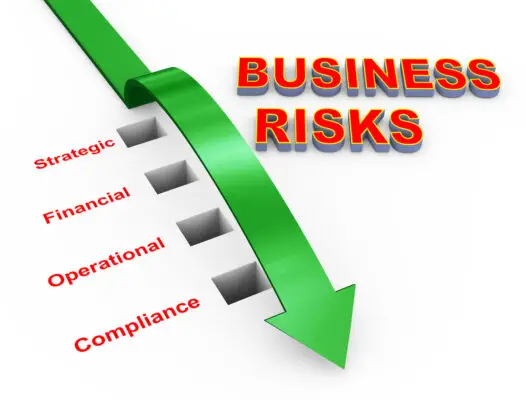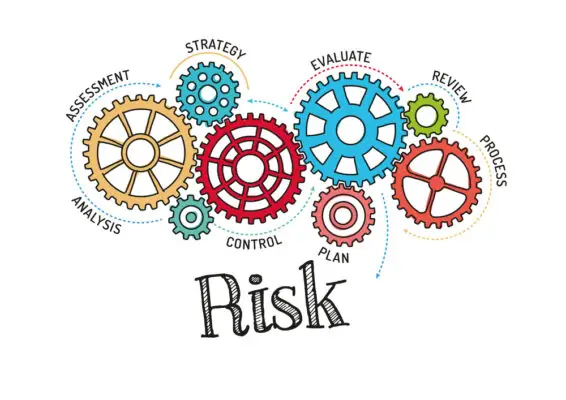Bankers worldwide face various kinds of risks and can take risks. As everyone knew from the 2008 crisis, risks within the financial industry can significantly affect global economic activity. To assess banks’ risks, they should use the Key Risk Indicator.
Key risk indicators are measures used to assess the status of risks: the possibility of a risk event and the possible consequences of the event causing it. KRIs are indicators of a potential danger which could impact the bank’s financial success. KRIs can be a vital part of managing risk in a bank.
The banking market is changing, and the risks in one area can impact another quickly if not always. Cybersecurity risks remain the top of the top risks for a majority of banks, according to ABA Banking Journal.
There is always a security risk at every institution, and banks must monitor technological advancements to avoid a cyber attack. In addition, other risks can be considered, aside from ransomware and cybercrime.
In the banking industry, there are a variety of risk indicators that analysts and investors use to evaluate both the health of the industry and individual banks. Banks face a variety of risks on a daily basis.
These risks can come from many different sources, including credit risk, market risk, interest rate risk, and liquidity risk. To identify and manage these risks, banks rely on key risk indicators (KRIs).
Key risk indicators (KRIs) are numerical values that indicate the level of risk in a banking institution. They are used to identify, measure, and manage risk. There are three types of KRIs: financial, operational, and compliance. Financial KRIs measure the financial health of a bank. Operational KRIs measure the effectiveness of a bank’s operations.
Compliance KRIs measure a bank’s compliance with regulations. Each KRI has its own set of metrics. For example, a financial KRI might be the ratio of non-performing loans to total loans. An operational KRI might be the number of customer complaints per month.
A compliance KRI might be the percentage of loans that comply with regulations. KRIs can be used to assess both short-term and long-term risks. For example, a short-term risk might be a sudden increase in the number of customer complaints. A long-term risk might be a trend of increasing non-performing loans. Kris can help banks identify and manage risks before they turn into problems.
To protect your company’s finances, monitoring a range of risk indicators is important. Financial risks can be monitored using indicators such as the price of raw materials, the level of consumer confidence, or the performance of stock markets.
In this blog post, we’ll define KRIs and discuss some of the most common indicators used by banks.

Key risk indicators defined
Key risk indicators have been a key tool for Risk Management and are used to increase risk surveillance and reduction as well as facilitate risk reporting. Operational risks refer to risks from inadequate internal processes resulting from inadequate personnel and system systems.
Operational KRIs are measures which enable risk management to detect potential fatalities. These measures are intended for measuring the risk profile of an organisation.
What are key risk indicators for banks?
KRIS is defined as a quantifiable metric used by banking executives to evaluate the potential risks associated with the execution of an activity. The KRI is intended to help warn of potential danger, rather than measure a situation. The following indicator has been designed and used by financial institutions to predict risks impacting their business and to provide a forward view for the future application of the risk event.
Importance of KRIs
Kris plays a critical role in determining the risks in the area and providing rapid action. Kris allows firms to assess current or emerging risks. Show control deficiencies by allowing stronger control over weak control. Ensure escalating risk reporting. Operational Risk Control adds value to the company.
Examples of Key risk indicators for Banking
Loan-to-deposit ratio
The loan-to-deposit ratio (LDR) is a measure of a bank’s lending risk. It is the percentage of a bank’s loans that are funded by its deposits. A high LDR indicates that a bank is relying heavily on borrowing to fund its operations, which makes it more vulnerable to changes in interest rates and economic conditions.
A low LDR, on the other hand, indicates that a bank has a large number of deposits relative to its outstanding loans, giving it more flexibility to weather changes in the market. While there is no perfect LDR for all banks, most experts agree that a ratio of less than 80% is ideal. This gives banks enough room to make loans without putting their depositors at risk.
Non-performing loans
A non-performing loan (NPL) is a loan that has not been repaid by the borrower and is no longer considered performing under the original terms of the loan. Non-performing loans are often sold by banks at a discount to investors who are willing to take on the risk of collecting on the debt
Nonperforming loans are loans that have been delinquent for 90 days or more. They are an important risk indicator because they give analysts and investors a sense of how well a bank is performing in terms of its loan portfolio. If a large percentage of a bank’s loans are nonperforming, it may be indicative of poor underwriting standards or aggressive lending practices.
NPLs can be a drag on bank profitability, as they tie up capital that could be used to make new loans. In addition, NPLs may require special provisions that increase the number of reserves that banks must set aside. As a result, banks typically view NPLs as a last resort and try to work with borrowers to restructure their loans before they become non-performing.

Capital adequacy ratio
The capital adequacy ratio is a financial ratio that banks are required to maintain in order to protect themselves against unexpected losses. The ratio is calculated by dividing a bank’s Tier 1 capital by its risk-weighted assets. Tier 1 capital includes items such as equity and retained earnings, while risk-weighted assets include loans and other assets that are weighted according to their riskiness. Generally, the higher the capital adequacy ratio, the more resilient a bank is to unforeseen losses. As such, regulators typically require banks to maintain a minimum capital adequacy ratio of 10%.
Liquidity ratio
The liquidity ratio is a ratio that measures a company’s ability to pay short-term debts. The ratio is calculated by dividing a company’s current assets by its current liabilities. A high liquidity ratio means that the company has more than enough assets to cover its debts, while a low liquidity ratio indicates that the company may have difficulty paying its debts. The ideal liquidity ratio will vary depending on the industry, but most experts agree that a ratio of 2:1 is generally healthy. A company with a lower liquidity ratio may be able to improve its financial health by selling off some of its assets or by taking out a loan.
Net interest margin
The net interest margin (NIM) is a financial ratio that measures the difference between the interest income generated by a financial institution and the amount of interest paid out to its lenders. NIM is used to assess a financial institution’s profitability and its ability to generate income from its lending activities. A higher NIM indicates a more profitable institution, while a lower NIM indicates an institution that is less profitable. The NIM can also be used to compare the profitability of different financial institutions.
Efficiency ratio
The efficiency ratio is a financial metric used to assess a company’s ability to generate profits from its operating activities. It is calculated by dividing operating expenses by net income. A high-efficiency ratio indicates that a company is using a large portion of its income to cover operating expenses, while a low ratio indicates that a company has a higher profit margin.
The efficiency ratio is an important tool for investors and analysts to use when evaluating companies, as it can give insight into a company’s profitability and growth potential. However, it is important to note that the metric should be used in conjunction with other financial measures, as it can provide only a limited view of a company’s overall financial health.
Operational risk: key risk indicators (KRIs)
Key Risk indicators operations risk mitigation is frequently mentioned within most content aimed at risk management. The risk exposure of risk events and key operational risk indicators to develop risk mitigation plans. The KRI framework can serve the company in developing an innovative risk management strategy.
Operational risk management in the banking sector is prioritized and the appointment of senior management is crucial .
Operational Risk Indicator Example # 1 – Percentage of projects currently in progress that are delayed (Overall)
The current number of projects which have been delayed. KRI is a method of quantifying project delay risk. A large rate of delayed projects can suggest that implementing an enterprise has a project that requires planning and resources or is not able to manage it. Excessive project delays can cause financial and reputational risks for the company.
Credit Risk Indicator Example # 2 – Current Ratio
A measuring method for determining a business’ current liquidity expressed in terms of total current liquid assets compared to illiquid debts. The KRI measure is used in the context of how an enterprise can pay its debts with the total assets. A value below a certain value indicates that the organization is liable for substantial losses which cannot be covered by the organization’s existing assets.
Credit Risk Indicator Example # 3 – Days payable outstanding (DPO)
KRI is measured using a risk metric – Generally based on the company’s suppliers or the supplier. Low DPO numbers might cause cash flow problems (i.e. paying suppliers in excess of time), while higher DPOs can adversely affect certain credit terms. Accounting payable departments must find a balance that best suits the company’s cash flow requirements.
Operational Risk Indicator Example # 4 – Percentage of Journal Entries Performed Manually
A number of journal entries are automatically generated, based on the number of journal entries made during measurement. KRI is the measure of the risks associated with a highly-manually-manual journal entry process.
A large amount of manually worked journal entries and related accounting procedures greatly increase the occurrence of errors and omissions and unauthorized activities (e.g. unauthorized goods and documents etc.) in journal entries and general ledger operations. Manual journals may increase cycles and expenses for any related accountancy functions as well.
Credit Risk Indicator Example # 5 – Quick Ratio
Liquidity Risk Definition measures the liquidity of a business entity in monetary units. Reason for determining this KRI: This measure is a measure of how quickly the company can repay its present liabilities by leveraging liquid assets in the company’s finances.
An extremely low value for the value is a sign that an organisation is taking on huge liabilities which are not covered by existing assets. This could result in organizations being liable for financial loss and the financial and reputational penalties associated with it.
Operational Risk Indicator Example # 6 – Number of Regulatory Report Restatements
A total number of reviewed reports related to external regulation financial reports During measuring periods. Justification for measuring these KRIs – These metrics measure the risk presented by a regulatory report which contains inaccuracies or errors. Generally accepted accounting principles followed for financial reporting processes and key risks need to be stated.
Errors and incomplete regulatory reports are potentially damaging to regulators, audits and reputational harm. Any pending report reconciliations can impact organizational capacity or deplete responsibilities in the financial department.
Operational Risk Indicator Example # 7 – Number of Management Report Restatements
Total amount reported by management on internal finances during a measurement period. The rationale for assessing KRIS. These metrics measure the risk that arises when management reports contain omissions and inaccuracies that can cause an incorrect presentation of the financial well-being of organizations.
An inaccurate financial statement may hamper a company’s ability to make decisions in relation to organizational liquidity, investment, and budgeting.
Operational Risk Indicator Example # 8 – Budget Variance (Budgeted vs. Actual) – Firm-Wide
The monetary difference between the Company’s budgeted expenses and its actual charges during the measured period. KRI is measured in metric terms, based on costs that are under or over estimate that could cause problems with short-term liquidity and/or the allocation of capital throughout the organization.
Budget variances can indicate outdated or incorrect forecasts or changes in a business environment causing increased uncertainty in budgeting.

Operational Risk Indicator Example # 9 – Number of Detected Deviations from GAAP
A total number of detected deviations from GAAP for a given measurement period. KRI is an indicator of the risk of deviation from a GAAP accounting or reporting system.
The failure to adhere to the GAAP principles could create a financial loss, potential fraud or regulatory issue that exposes the business to significant financial and social risks. Poor practices can also negatively affect organisational capability due to excessive rework.
Credit Risk Indicator Example # 10 – Percentage of Invoices Paid On-Time
The percentage of all invoice payments paid in full during the same period. Justification for evaluating the KRI. It measures risks arising in the organisation’s adherence to credit terms specified in invoices and suppliers’ contracts.
An excessive amount of late invoices can negatively influence credit conditions with certain suppliers. Some suppliers will even have special pricing incentives if you repeatedly pay your invoice on time, early or avoid costs.
Conclusion
Banks use a variety of ratios to monitor financial health and performance. The six most common are the loan-to-deposit ratio, non-performing loans, capital adequacy ratio, liquidity ratio, net interest margin, and efficiency ratio. Each ratio measures something different but all work together to give a clear picture of the current state and future prospects of the bank. Do you have questions about any of these ratios or how they are used?

Chris Ekai is a Risk Management expert with over 10 years of experience in the field. He has a Master’s(MSc) degree in Risk Management from University of Portsmouth and is a CPA and Finance professional. He currently works as a Content Manager at Risk Publishing, writing about Enterprise Risk Management, Business Continuity Management and Project Management.

